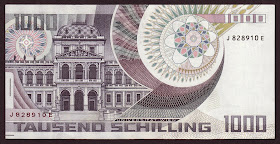Austria Banknotes 1000 Schilling banknote 1983 Erwin Schrödinger
National Bank of Austria - Österreichische Nationalbank
Obverse: Portrait of the Austrian physicist and Nobel laureate in physics Erwin Schrödinger (1887-1961). Coat of arms of Austria at upper left.
Reverse: University building in Vienna.
Watermark: Stylised eagle from Austrian coat of arms and parallel vertical lines.
Original size: 152 x 72 mm.
Designed by Robert Kalina.
Introduced: 14. November 1983. Withdrawn: 20. April 1998.
Austria banknotes - Austria paper money
1982-1988 Issue
20 Schilling 50 Schilling 100 Schilling
500 Schilling 1000 Schilling 5000 Schilling
Erwin Schrödinger
Erwin Rudolf Josef Alexander Schrödinger (12 August 1887 – 4 January 1961), sometimes written as Erwin Schrodinger or Erwin Schroedinger, was a Nobel Prize-winning Austrian physicist who developed a number of fundamental results in the field of quantum theory, which formed the basis of wave mechanics: he formulated the wave equation (stationary and time-dependent Schrödinger equation) and revealed the identity of his development of the formalism and matrix mechanics. Schrödinger proposed an original interpretation of the physical meaning of the wave function.
In addition, he was the author of many works in various fields of physics: statistical mechanics and thermodynamics, physics of dielectrics, colour theory, electrodynamics, general relativity, and cosmology, and he made several attempts to construct a unified field theory. In his book What Is Life? Schrödinger addressed the problems of genetics, looking at the phenomenon of life from the point of view of physics. He paid great attention to the philosophical aspects of science, ancient and oriental philosophical concepts, ethics, and religion. He also wrote on philosophy and theoretical biology.
He is also known for his "Schrödinger's cat" thought-experiment.
University of Vienna
University of Vienna, German Universität Wien, state-financed coeducational institution for higher learning at Vienna. Founded in 1365, it is the oldest university in the German-speaking world.
The university was first chartered, following the model of the University of Paris, by the Habsburg duke Rudolf IV of Austria, as an expression of his rivalry with German king Charles IV, who had founded the University of Prague in 1348. After Rudolf’s brother and successor, Albert III, reorganized the foundering university in 1384, endowing it generously, broadening the curriculum, and making enrollment more geographically comprehensive, Vienna achieved first rank among universities in the German-speaking east, with special distinction in medicine, law, and theology.
The university was a centre of revolution in 1848 and in 1850 won important reforms, including greater freedom for teachers and students, the seminar method of instruction, and a wider selection of subjects. In 1878 women were admitted to study in the philosophy (liberal arts) faculty on a limited basis, broadened 11 years later; in 1900 the medical school became coeducational, in 1919 the law school. The modern university includes faculties of Roman Catholic and of Protestant theology, social sciences and economics, medicine, basic and general sciences, human sciences, and mathematics and natural sciences.

